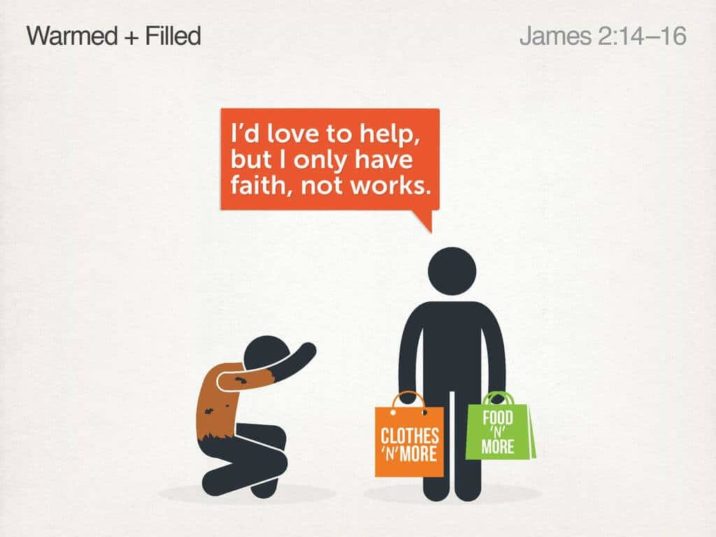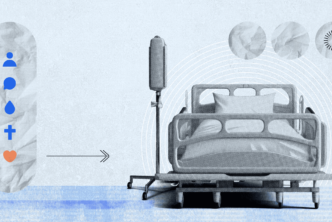Some fans of Dr. Runge have claimed that his discourse works alone have made Logos worth it.
If you’re not familiar with Dr. Runge’s work, his biblical language expertise helps modern readers navigate the intricacies of biblical Greek and Hebrew, often shedding light on how the particular phrasing of Scripture emphasizes the points it communicates. His clearly articulated discourses both lead you through the language of Scripture, and teach you the art of effective discourse—as demonstrated by the Bible.
Here’s how Dr. Runge breaks down James 2:14–26 and faith without works in the High Definition Commentary: James:
James introduces the next big idea using a rhetorical question (“What good is it . . .”) in verse 14. His question draws our attention to the key thought for what follows. He begins by asking what the point of something is, but then he delays telling us exactly what that is by inserting “my brothers.” This expression does not signal a shift to a new audience or subaudience; instead, this delay highlights James’ introduction to the topic of having faith without works. In Greek, emphasis is used to highlight contrast—in this case, the contrast between faith and works.
James also offers an unnerving follow-up question at the end of verse 14—one that anticipates a negative answer. His question calls into doubt whether such a faith could save someone. Warning: We need to pay close attention to what James actually says and not mistake it for what he does not say. The focus here is not disputing whether faith is the basis of salvation. Instead, just as James contrasted the merits of hearing versus doing, he contrasts the value of faith alone versus faith that manifests itself in works. And just as James argued that hearing should lead to doing (1:22–25), he posits that faith—if it really exists—should lead to an outward expression: works. From the outset James shakes us by implying that a workless faith may not be a saving faith. This is only an implication of his wording, but it has caused no shortage of heartburn for theologians over the years.
Evidence of Faith: How is it possible for others to see whether you have faith or to see the quality of that faith? Since faith is not tangible in itself, the only real way faith can be verified is by seeing it in action. Sure, we can claim to have faith, but James rightly questions whether faith that is never seen is really the kind of faith that can save us. Later, in verse 18, he challenges those claiming to have faith to prove it to him without any works to demonstrate it. Putting faith into action gives others a chance to see and test its quality.
In verse 15, James offers a practical illustration of the difference he sees between applied faith and a claim of faith that never manifests itself in works. His scenario introduces people who are most likely believers, based on his use of “brother or sister.” These family terms imply kinship of some kind—in this case, membership in the family of God. The people are defined by what they lack: adequate clothing and sufficient daily food. James shifts from generic people to potential members of the audience in verse 16 by saying “one of you.” This again implies that James is focused on believers helping other believers. The key element of the scenario is whether believers are helping others in need. Instead of offering them something from their own goods or helping them find provision elsewhere, these people are simply offering a blessing, with no practical assistance.
Warmed + Filled: To illustrate the emptiness of a faith without works, James hypothesizes a scenario where a brother or sister in Christ is in need, but a believer offers only a blessing instead of something practical that would help meet their need. While this might technically qualify as faith, James says that faith is dead unless it is accompanied by works.James delivers his carefully worded verdict regarding this kind of faith. His wording is deliberate, so we should be careful not to read too much into it; James is not staging a faith-versus-works smackdown. He highlights his key point about faith in this verse. First, there is a condition: “if it does not have works.” This makes clear that faith is still a necessary component of salvation, one that cannot simply be replaced by works. Then, at the end of the verse, he adds, “by itself.” This again drives home the point that faith must be put into practice, just like hearing must be accompanied by doing (see James 1:22–25). And what can we say about this kind of faith that is not practiced? It is dead, James says. He even shifts the order of the words to emphasize “dead” in Greek so there is no missing his point.
You might think James has built a pretty airtight case to win his argument. But he takes it one step further, anticipating a potential objection in verse 18. It is essentially a “Yes, but . . . ” objection to his initial point in verse 14 about the futility of someone saying they have faith but not works. I can almost hear the objection: “You just don’t understand. I have faith, but you have works. Each part of the body is different, right, each fulfilling its unique role?” Again, James places emphasis on faith and works to highlight the contrast.
How does James respond to this objection? By highlighting the emptiness of the claim, challenging them to show him their faith without using works to do it. Meanwhile, James shows them his faith by taking actions that demonstrate and exercise his faith. Faith is one of many abstract things that we can’t see. We talk about “having” or “possessing” these things, but they can’t be seen unless they are “exercised” or “applied.” For instance, I could say that I have compassion, or that I have good ideas, creativity, or even anger-management issues! You could take my word for it, but it’s more likely you would look for evidence of these traits in how I live. This would require me to do something to show you. If intangible concepts—like compassion and faith—are not put into practice, we have no proof they exist.
We have lots of idioms in American English that express the same sentiment that James offers in the second part of verse 18: Take “put up or shut up,” or “actions speak louder than words.” Missouri is the “Show me” state. “Talk is cheap” implies that actions are more difficult and therefore more valuable. When we describe people who didn’t follow up on what they said, we say that they only gave “lip service.” When it comes to whether a person really possesses an intangible quality, like faith, asking to see it in practice does not negate its importance or supplant the value of the practice. It is in keeping with the old Russian proverb popularized in English by President Ronald Reagan, “Trust, but verify.” If someone consistently claims to have faith, yet consistently fails to demonstrate it in their life, James’ challenge is fitting. Can faith that is never seen really be a saving faith? Is it really there if it is never seen? God is undoubtedly the final judge of such things, but there are no “do-overs” when we stand before the judgment seat.
To work through the rest of James with Dr. Runge, order the High Definition Commentary: James.
See for yourself what Runge fans are talking about—get Lexham Discourse bundle.





